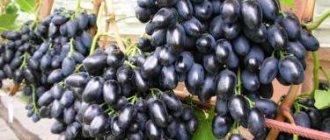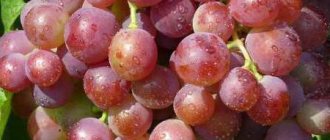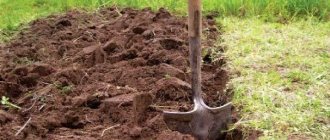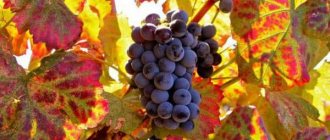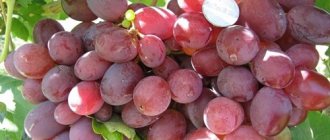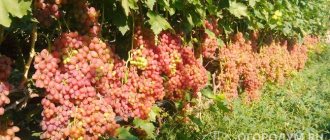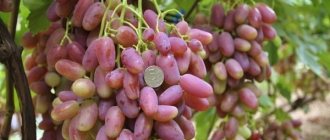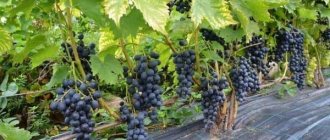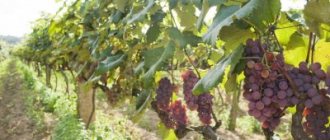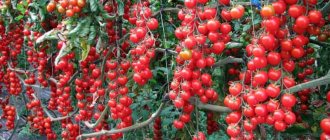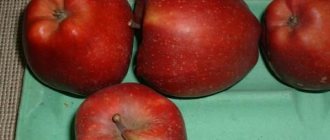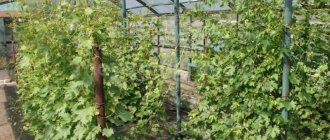Which group does it belong to?
The “Svetlana” grape (other name FVR-7-9, I-8-7-9) belongs to the group of white table-type varieties with an early or mid-early ripening period of 117 to 125 days.
Among white table varieties, Vostorg Bely, Amethyst Novocherkassky and Amirkhan are also popular.
Intended for fresh consumption. It has an excellent presentation due to the presence of large, attractive bunches, pleasant taste and aroma.
It has fleshy, juicy flesh with a moderately dense skin that is easy to bite off. The taste is balanced , harmonious, with light notes of nutmeg. Transportability and keeping quality are good.
Due to the functionally female type of flowering, when planting this variety, it is better to place it next to varieties with bisexual flowers that bloom at the same time.
The varieties Red Delight, Korolek and Ruta also have female flowers.
Appearance of grapes
In appearance, the fruits of the Svetlana grapes resemble the Kesha (Talisman) variety.
The size of the clusters is very large , the average weight is from 800 to 1200 g. Vostorg, Merlot and Bazhena can boast of equally large clusters
Density – medium. The shape is conical. Although, depending on care and growing conditions, the clusters may be shapeless. The berries are very large in size and weight.
On average, their size is about 35 x 31 mm, weight - from 14 to 16 g. Color - white. The number of seeds in large berries is from 1 to 3. Smaller fruits do not have seeds.
It has a high sugar content of 17-23% and fairly low acidity (6-8 g/l). The safety of the crop on the bushes is high. Closer to autumn, the grapes partially raisinize, without losing their taste.
Bianka, Aladdin and King Ruby can also boast a high sugar content.
It is one of the vigorous varieties with high rooting of shoots. Due to the large weight of the bunches and berries, they may be subject to additional stress during the fruiting period, so they must be partially removed.
Due to its ability to form full-fledged, high-quality clusters from corner, replacement and dormant buds, it has good yields in years with unfavorable climatic conditions. It has increased fruitfulness of the eyes in the lower part of the shoots.
To obtain a good harvest of Svetlana grapes with beautiful, large, regularly shaped fruits, excellent taste characteristics and good transportability, short or medium pruning (5-7 buds) must be used to form it.
How to choose the best seedlings
The key to abundant harvests and good grape growth rates are high-quality healthy seedlings. When purchasing planting material, experts advise, first of all, to carry out a visual inspection of it for the presence of mechanical damage, rotten areas, and dry roots.
It is recommended to pay special attention to:
- Root system . The roots should not have dry, rotten roots, any mechanical damage or signs of pests. The seedling must have strong, strong, healthy root shoots that are sufficiently dense and hard to the touch.
- Leaves . You should not buy a plant with a large number of leaves and a woody trunk, as they will take away moisture from the seedling, as a result of which it will take root poorly and will bear fruit poorly.
- Escapes . High-quality planting material should have fully matured shoots with a couple of well-formed buds. The diameter of the cutting must be at least 5 mm.
- Vine and bark . To check the viability of the vine, it is necessary to make a small cut on the surface: in a healthy seedling it is moist and green in color. Dull color and dryness indicate “deadness” of the material. You can check the bark in the same way - the scraping area should be green and not dry.
- Age . The best option is considered to be seedlings no more than two years old.
Broom: description, views with photos, planting and care in the Moscow region
Photo
History of selection and region of breeding
The hybrid form of the Svetlana grape was bred at VNIIViV named after. Ya.I. Potapenko, in the Rostov region, Novocherkassk.
The Talisman and Rusbol varieties were used as the basis for its production. The authorship of the breeding of the variety belongs to the Russian breeder, Svetlana Ivanovna Krasokhina, a leading researcher at the institute’s breeding laboratory.
Unlike the parent varieties, this variety of white table grapes has a shorter ripening period (5-7 days earlier than Talisman).
In central Russia it begins to ripen between the 15th and 20th of August. Currently cultivated in Russia, as well as in the vineyards of Ukraine and Belarus.
The same research institute produced varieties such as Vityaz, Demeter and Ilya.
Agricultural technology
- The Svetlana grapes require harvest rationing. This is explained by the large weight of the bunches, which put a high load on the bush.
- It is better to do medium or short pruning - 5-7 eyes. Both spring and autumn pruning are allowed.
- Despite the fact that the variety is resistant to mildew and gray rot, it is better not to neglect preventive scheduled treatments. 2-3 treatments per season will be enough.
- For the full development of the plant, mineral and organic fertilizers are necessary. They are carried out in accordance with the general rules for caring for grapes.
Description of the variety Svetlana
The variety is hardy , frost-resistant , able to withstand negative temperatures down to -25 degrees.
One of the advantages of this grape is its high yield. The number of fruiting shoots on a bush is usually up to 90%. The number of bunches per shoot ranges from 1.5 to 1.8 pieces.
High productivity is also demonstrated by the Anniversary of the Kherson Summer Resident, Rkatsiteli and Magarach's Gift.
As a rule, 2 inflorescences grow on a shoot, although sometimes their number increases to 3. It is resistant to gray rot and mildew.
Unpretentious to soil conditions, simple in agricultural technology. Need for preventive treatment against fungal infection: 1 – 2 times per season. Grows well with rootstocks. Tasting assessment of fresh grapes: 8.3 points.
Care
Let's get acquainted with the features of agricultural technology when growing Svetlana grapes.
Watering
Grapes, of course, need to moisten the soil, but the frequency and volume of watering depends in this case on weather conditions. An approximate diagram is as follows:
- In the spring - in the middle or towards the end, if there is rain and the ground has dried out after the snow melts, the first watering is carried out. At the same time, the vine is tied to the trellis. The first watering is always plentiful; it is advisable to dissolve wood ash in the water for additional nutrition of the grapes.
- The second watering is done about a week before flowering.
- During the flowering period, you should not water the vine, as this will only harm it. The fact is that when the soil is abundantly moistened during this period, the grapes drop their flowers. The harvest is therefore unlikely to be abundant.
- After flowering is completed, water too. But only if there is no rain and the ground is dry.
- After fruit filling begins, soil moisture is stopped. If you continue to water, the berries will turn out tasteless and watery.
- The last mandatory watering is done in the fall after the crop is harvested. This procedure is aimed at protecting the roots from freezing in winter. Large quantities of water should be used.
Attention: do not use the sprinkling method for this grape variety. Surface splashing of water leads to plant disease, the appearance of fungus and rot on its leaves. The best option is root or underground watering, when the pipes are connected directly to the roots.
Trimming
To get a high-quality harvest and make the berries large, it is necessary to regulate the number of ovaries. If this procedure is not carried out, the grape bunches will be small and the berries will not be sweet enough.
As for formative pruning, it can be done both in spring and autumn. Short pruning is better in this case: 5-7 eyes, no more. Typically, gardeners form shrubs in the traditional fan way.
In spring, it is recommended to thin out the bush. This is necessary in order to provide better access to sunlight and heat. Thinning also serves as an additional measure to prevent fungal diseases and pests.
To prevent shoots from growing too much upward, it is recommended to pinch them. This procedure is carried out only for young shoots; old ones are broken off or cut off.
Top dressing
In order for the vine to develop well and bear fruit successfully, timely feeding is necessary. You can use minerals; organic matter will also not be superfluous.
The timing of fertilizing is usual, standard for any grapes:
- In the spring, nitrogen and phosphorus are added to speed up the growth of green mass.
- Before flowering, the vines also add nitrogen and phosphorus, but this time there should be more phosphorus.
- During the ripening period, the grapes are fed with phosphates.
- After harvesting the fruits, potassium fertilizing, which is beneficial for the roots of the plant, will not hurt.
Characteristics and description of carrot variety Nantes 4, cultivation and care
Important: it is recommended to mulch the soil after applying liquid fertilizers. It is better to use organic materials, which, after overheating, will also become additional nutrition.
Weeding
Along with other caring procedures, grapes also need to be weeded. It is better to do this after watering and rains, since weeds are better obtained from damp soil. It is extremely undesirable to allow weeds to grow near the vineyard, since pests and rodents often live in the weeds, and infections are possible.
Prevention
Although the variety demonstrates high resistance to fungus, gray rot and mildew, preventative treatment will not hurt. It is recommended to carry out at least 2-3 such treatments per season: in spring and autumn.
The processing scheme could be like this:
- In the spring, grapes should be sprayed with Nitrofen, which has a complex effect. Remember that serious protective measures are required when working with this drug.
- Before the vine begins to bloom, treat it with any systemic fungicide.
- To prevent grapes from getting sick with oidium, treatment with Flint or Quadris is indicated in July.
- After harvesting the fruits, spray the vine with Flint or Strobi to protect it from rodents in winter.
Important: if the grapes become sick during the ripening process, the use of chemicals is strictly prohibited. In this case, use safe potassium permanganate or colloidal sulfur.
How to deal with wasps
Svetlana grapes are often affected by harmful flying insects. To get rid of wasps, you will have to take a whole range of protective measures.
- First, we strongly recommend getting rid of the nest. If the nest remains on or near the property, wasps will still be frequent visitors.
- Insecticides can also help in an unequal fight. The main thing is to choose drugs that will be safe for the crop.
- Many gardeners who grow grapes use special mesh bags that are placed directly on the bunches. The bags protect the crop from wasps and birds.
- A fine mesh net stretched over the vineyard can also help.
- Some people use poisonous baits with sweet contents.
You can learn more about caring for grapes from the video:
